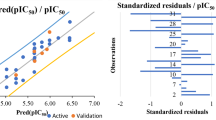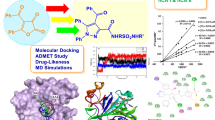Abstract
This study was designed to synthesize and evaluate flavanone derivatives with phenylcarbamate moiety as potent acetylcholinesterase (AChE) inhibitors and anti-amnestic agents for management of AD. The synthesis of carbamate-substituted flavanone derivatives involved base-catalysed Claisen-Schmidt condensation reaction of 2-hydroxy acetophenone/2-hydroxy-4,6-dimethoxyacetophenone with differently substituted benzaldehydes to yield differently substituted chalcones that underwent intra-molecular oxidative cyclization on refluxing with glacial acetic acid to yield flavanone compounds. Thereafter, refluxing of flavanone compounds with phenyl isocyanate in the presence of petroleum-ether and triethylamine provided phenyl carbamate-substituted flavanone derivatives. The synthesized compounds were screened in vitro for AChE inhibitory activity with donepezil as the standard drug. The most potent test compound (5f′) was evaluated in vivo for memory restorative actions in scopolamine (0.4 mg/kg)-induced amnesia in mice by Morris water maze test. All the compounds exhibited AChE inhibitory activity with carbamate substituted 5,7-dimethoxyflavanone derivatives (5a′–5g′) being the most potent compounds with IC50 ranging from 21.5 ± 1.8 to 9.9 ± 1.6 nM. Compound 5f′ also ameliorated scopolamine-induced amnesia in mice in terms of restoration of time spent in target quadrant and escape latency time. It may be concluded that phenylcarbamate-substituted 5,7-dimethoxyflavanones may be a promising structural template for the development of novel AChE inhibitors in managing amnestic disorders including AD.





Similar content being viewed by others
References
Bachurin SO (2003) Medicinal chemistry approaches for the treatment and prevention of Alzheimer’s disease. Med Res Rev 23(1):48–88
Bartolini M, Bertucci C, Cavrini V, Andrisano V (2003) β-Amyloid aggregation induced by human acetylcholinesterase: inhibition studies. Biochem Pharmacol 65(3):407–416
Bolognesi ML, Bartolini M, Cavalli A, Andrisano V, Rosini M, Minarini A, Melchiorre C (2004) Design, synthesis, and biological evaluation of conformationally restricted rivastigmine analogues. J Med Chem 47(24):5945–5952
Cabrera M, Simoens M, Falchi G, Lavaggi ML, Piro OE, Castellano EE, Vidal A, Azqueta A, Monge A, de Ceráin AL, Sagrera G, Seoane G, Cerecetto H, González M (2007) Synthetic chalcones, flavanones, and flavones as antitumoral agents: biological evaluation and structure-activity relationships. Bioorg Med Chem 15(10):3356–3367
Castro A, Martinez A (2001) Peripheral and dual binding site acetylcholinesterase inhibitors: implications in treatment of Alzheimer’s disease. Mini Rev Med Chem 1(3):267–272
Cheng DH, Tang XC (1998) Comparative studies of huperzine A, E2020, and tacrine on behavior and cholinesterase activities. Pharmacol Biochem Behav 60(2):377–386
Colombres M, Sagal JP, Inestrosa NC (2004) An overview of the current and novel drugs for Alzheimer’s disease with particular reference to anti-cholinesterase compounds. Curr Pharm Des 10(25):3121–3130
De Ferrari GV, Canales MA, Shin I, Weiner LM, Silman I, Inestrosa NC (2001) A structural motif of acetylcholinesterase that promotes amyloid beta-peptide fibril formation. Biochemistry 40(35):10447–10457
Ellman GL, Courtney KD, Andres V Jr, Feather-Stone RM (1961) A new and rapid colorimetric determination of acetylcholinesterase activity. Biochem Pharmacol 7:88–95
Jung M, Park M (2007) Acetylcholinesterase inhibition by flavonoids from Agrimonia pilosa. Molecules 12(9):2130–2139
Kim YW, Hackett JC, Brueggemeier RW (2004) Synthesis and aromatase inhibitory activity of novel pyridine-containing isoflavones. J Med Chem 47(16):4032–4040
Kim H, Park BS, Lee KG, Choi CY, Jang SS, Kim YH, Lee SE (2005) Effects of naturally occurring compounds on fibril formation and oxidative stress of β-amyloid. J Agric Food Chem 53(22):8537–8541
Ladner CJ, Lee JM (1998) Pharmacological drug treatment of Alzheimer disease: the cholinergic hypothesis revisited. J Neuropathol Exp Neurol 57(8):719–731
Lin G, Lai CY, Liao WC (1999) Molecular recognition by acetylcholinesterase at the peripheral anionic site: structure-activity relationships for inhibitions by aryl carbamates. Bioorg Med Chem 7(12):2683–2689
Lin YM, Zhou Y, Flavin MT, Zhou LM, Nie W, Chen FC (2002) Chalcones and flavonoids as anti-tuberculosis agents. Bioorg Med Chem 10(8):2795–2802
Morris RGM (1984) Developments of a water maze producer for studying spatial learning in the rats. J Neurosci Meth 11:47–60
Mustazza C, Borioni A, Del Giudice MR, Gatta F, Ferretti R, Meneguz A, Volpe MT, Lorenzini P (2002) Synthesis and cholinesterase activity of phenylcarbamates related to Rivastigmine, a therapeutic agent for Alzheimer’s disease. Eur J Med Chem 37(2):91–109
Rees T, Hammond PI, Soreq H, Younkin S, Brimijoin S (2003) Acetylcholinesterase promotes beta-amyloid plaques in cerebral cortex. Neurobiol Aging 24(6):777–787
Richetti SK, Blank M, Capiotti KM, Piato AL, Bogo MR, Vianna MR, Bonan CD (2011) Quercetin and rutin prevent scopolamine-induced memory impairment in zebrafish. Behav Brain Res 217(1):10–15
Selkoe DJ (2002) Deciphering the genesis and fate of amyloid beta-protein yields novel therapies for Alzheimer disease. J Clin Invest 110(10):1375–1381
Shen Y, Zhang J, Sheng R, Dong X, He Q, Yang B, Hu Y (2009) Synthesis and biological evaluation of novel flavonoid derivatives as dual binding acetylcholinesterase inhibitors. J Enzyme Inhib Med Chem 24(2):372–380
Sheng R, Lin X, Zhang J, Chol KS, Huang W, Yang B, He Q, Hu Y (2009) Design, synthesis and evaluation of flavonoid derivatives as potent AChE inhibitors. Bioorg Med Chem 17(18):6692–6698
Sterling J, Herzig Y, Goren T, Finkelstein N, Lerner D, Goldenberg W, Miskolczi I, Molnar S, Rantal F, Tamas T, Toth G, Zagyva A, Zekany A, Finberg J, Lavian G, Gross A, Friedman R, Razin M, Huang W, Krais B, Chorev M, Youdim MB, Weinstock M (2002) Novel dual inhibitors of AChE and MAO derived from hydroxy aminoindan and phenethylamine as potential treatment for Alzheimer’s disease. J Med Chem 45(24):5260–5279
Wang CN, Chi CW, Lin YL, Chen CF, Shiao YJ (2001) The neuroprotective effects of phytoestrogens on amyloid beta protein-induced toxicity are mediated by abrogating the activation of caspase cascade in rat cortical neurons. J Biol Chem 276(7):5287–5295
Zhu JT, Choi RC, Chu GK, Cheung AW, Gao QT, Li J, Jiang ZY, Dong TT, Tsim KW (2007) Flavonoids possess neuroprotective effects on cultured pheochromocytoma PC12 cells: a comparison of different flavonoids in activating estrogenic effect and in preventing beta-amyloid-induced cell death. J Agric Food Chem 55(6):2438–2445
Acknowledgments
The authors duly acknowledge the financial support from UGC New Delhi, India, through the research scheme no. 39-716/2010 (SR). The authors are also thankful to Dr Nirmal Singh, Associate Professor in Department of Pharmaceutical sciences & Drug Research, Punjabi University, Patiala for his valuable suggestions.
Author information
Authors and Affiliations
Corresponding author
Rights and permissions
About this article
Cite this article
Anand, P., Singh, B. Synthesis and evaluation of novel carbamate-substituted flavanone derivatives as potent acetylcholinesterase inhibitors and anti-amnestic agents. Med Chem Res 22, 1648–1659 (2013). https://doi.org/10.1007/s00044-012-0162-3
Received:
Accepted:
Published:
Issue Date:
DOI: https://doi.org/10.1007/s00044-012-0162-3




